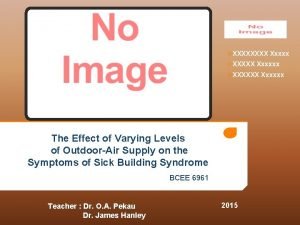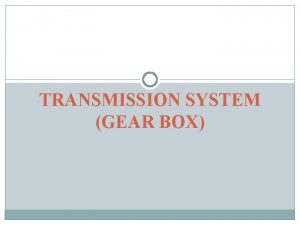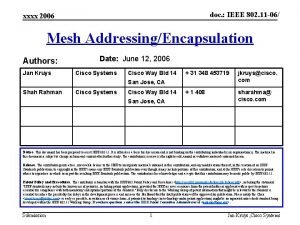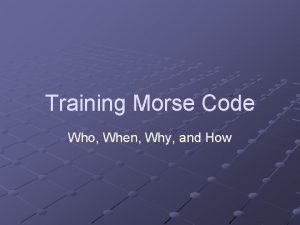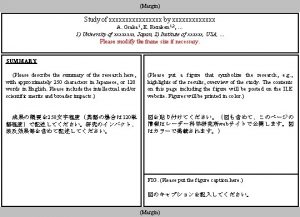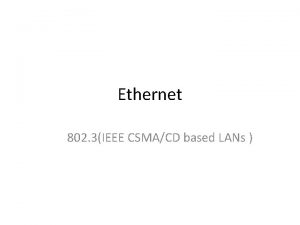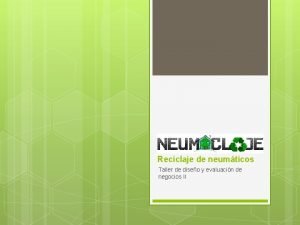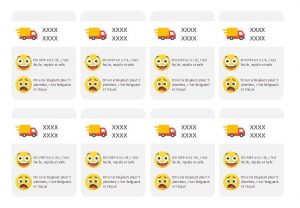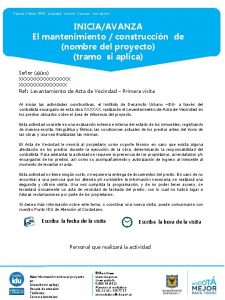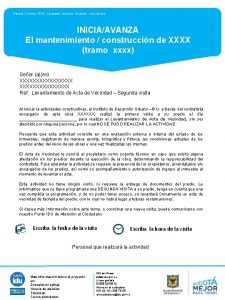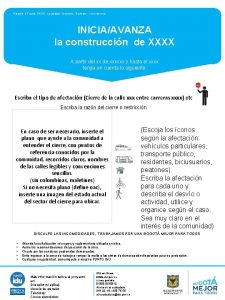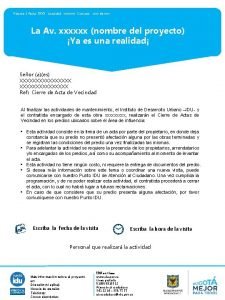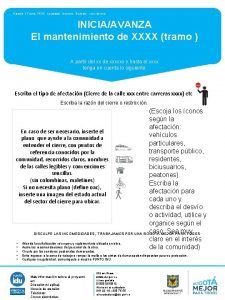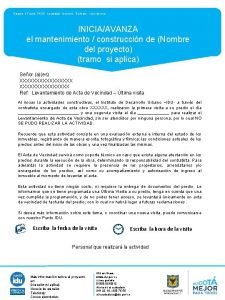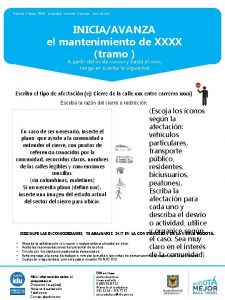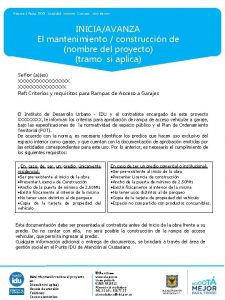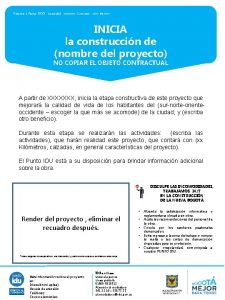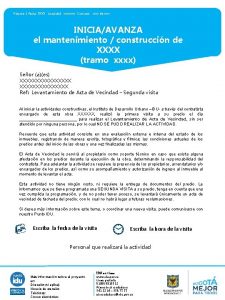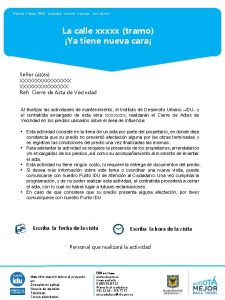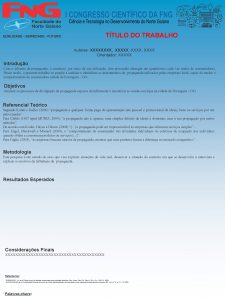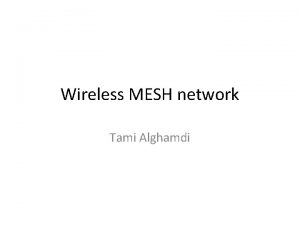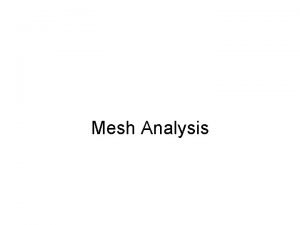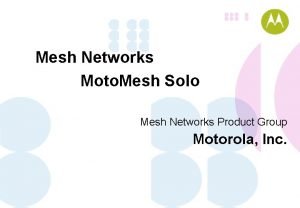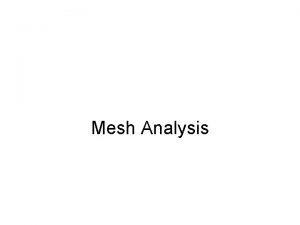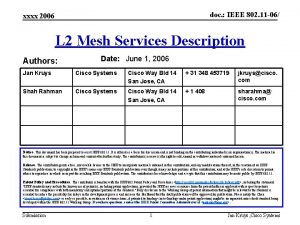doc IEEE 802 11 06 xxxx 2006 Mesh



















- Slides: 19

doc. : IEEE 802. 11 -06/ xxxx 2006 Mesh Addressing/Encapsulation Authors: Jan Kruys Date: June 12, 2006 Cisco Systems Cisco Way Bld 14 + 31 348 453719 jkruys@cisco. com + 1 408 sharahma@ cisco. com San Jose, CA Shah Rahman Cisco Systems Cisco Way Bld 14 San Jose, CA Notice: This document has been prepared to assist IEEE 802. 11. It is offered as a basis for discussion and is not binding on the contributing individual(s) or organization(s). The material in this document is subject to change in form and content after further study. The contributor(s) reserve(s) the right to add, amend or withdraw material contained herein. Release: The contributor grants a free, irrevocable license to the IEEE to incorporate material contained in this contribution, and any modifications thereof, in the creation of an IEEE Standards publication; to copyright in the IEEE’s name any IEEE Standards publication even though it may include portions of this contribution; and at the IEEE’s sole discretion to permit others to reproduce in whole or in part the resulting IEEE Standards publication. The contributor also acknowledges and accepts that this contribution may be made public by IEEE 802. 11. Patent Policy and Procedures: The contributor is familiar with the IEEE 802 Patent Policy and Procedures <http: // ieee 802. org/guides/bylaws/sb-bylaws. pdf>, including the statement "IEEE standards may include the known use of patent(s), including patent applications, provided the IEEE receives assurance from the patent holder or applicant with respect to patents essential for compliance with both mandatory and optional portions of the standard. " Early disclosure to the Working Group of patent information that might be relevant to the standard is essential to reduce the possibility for delays in the development process and increase the likelihood that the draft publication will be approved for publication. Please notify the Chair <stuart. kerry@philips. com> as early as possible, in written or electronic form, if patented technology (or technology under patent application) might be incorporated into a draft standard being developed within the IEEE 802. 11 Working Group. If you have questions, contact the IEEE Patent Committee Administrator at <patcom@ieee. org>. Submission 1 Jan Kruys , Cisco Syatems

doc. : IEEE 802. 11 -06/ xxxx 2006 Rev 4 • Addresses similarities and difference with ST’s 6 address scheme • Proposes a way forward • Adds aggregation considerations Submission 2 Jan Kruys , Cisco Syatems

doc. : IEEE 802. 11 -06/ xxxx 2006 Agenda • Requirement • Basic Idea – changed • MAC Header Changes – Mesh Forwarding Header • Examples: – Case-I: Hybrid Routing – Case-II: Portal-Portal Communication – Case-III: Legacy Node Forwarding • Aggregation Considerations • Summary Submission 3 Jan Kruys , Cisco Syatems

doc. : IEEE 802. 11 -06/ xxxx 2006 Requirements • A mesh network transports MAC frames on behalf of user devices hanging off Mesh nodes • All instances require mesh specific information – including internal mesh addressing - to be included in the header • Moving packet content around for inserting bits and pieces is inefficient • Keeping intra-mesh headers separate from the user frame makes implementation easier as well as writing the standard • Such separation is called encapsulation Submission 4 Jan Kruys , Cisco Syatems

doc. : IEEE 802. 11 -06/ xxxx 2006 Basic Idea • Insert a simple “Mesh Forwarding header” inside the 802. 11 frame – It is at least 4 bytes: 3 bytes already decided (Seqnr &TTL) + new Mesh Forwarding flags. • One of those will indicate presence of intra mesh addressing • Use this generic header extension to support all of the following 802. 11 s features: – – Src<>Root<>Dst Hybrid Routing Link State Routing Legacy 802. 11 AP/STA connected to 802. 11 s nodes Portal<>Portal communication • Neutral w. r. t link-by-link or edge-to-edge encryption – See Notes page Submission 5 Jan Kruys , Cisco Syatems

doc. : IEEE 802. 11 -06/ xxxx 2006 MAC Header Changes (data frame) Octets: 2 2 6 6 6 2 4 Frame Control Dur Address 1 Address 2 Address 3 TA DA Seq Control Address 4 RA Qos Control Mesh Forwarding Control • SA 12 Mesh Addressing 0 -tbd 4 Payload FCS Field 0 -7 8 -23 0 -7 Octets: 6 Mesh Flags Mesh E 2 E Seq Number Time To Live Mesh DA Mesh SA encrypted Src MP: – Inserts “Mesh Forwarding Header” (next) – Sets “Mesh Addressing Field” bit in “Mesh Flags” if applicable • Dst MP: – Removes “Mesh Forwarding Header” Submission 6 Jan Kruys , Cisco Syatems

doc. : IEEE 802. 11 -06/ xxxx 2006 Mesh Forwarding Header Octets: 1 8 -23 0 -7 Octets: 6 Mesh Flags Mesh E 2 E Seq Number Time To Live Mesh DA Mesh SA Basic MFH • Extended MFH Src MP sets: – Mesh SA = Itself – Mesh DA = Non-End-Point Mesh DA – “local source” flag for legacy STA source • Intermediate MPs do: – Checks “Mesh Address Field” bit and if set: – Drops if Mesh DA is unknown - means either hybrid routing without setting up a route or on-demand route set-up must be completed before the “tunnel” can be used • Dst MP: – Removes Mesh Forwarding Header – May use Mesh SA + local source flag to trigger a reverse on-demand path discovery • Presence of Mesh SA means source is in the mesh. Submission 7 Jan Kruys , Cisco Syatems

doc. : IEEE 802. 11 -06/ xxxx 2006 Other considerations • Inserting a forwarding control/addressing string after the legacy address fields is not elegant but it makes a lot things easier: – The first four addressing fields retain their current meaning – The forwarding string is only needed i. c. of forwarding - it can be left off, e. g. for intra mesh traffic. – The same string gets inserted at the source MP and removed at the destination MP • The string is “owned” by the forwarding service. • Keeping Qo. S Control with the legacy hdr assures that hardware Qo. S can process these frames • Encapsulation can be added easily – Another flag in the Mesh Flags to indicate multiple payloads • A new payload field is required for multiple payloads – Each frame carried as payload will have to retain its own SA/DA • In that case the SA/DA of the legacy header become meaningless Submission 8 Jan Kruys , Cisco Syatems

doc. : IEEE 802. 11 -06/ xxxx 2006 Examples of use • Three cases: Hybrid routing, Link State Routing, Legacy node forwarding and Portal to Portal. • All assume a single legacy payload being carried. – We have to look at TGn before we address the multiple payloads issues Submission 9 Jan Kruys , Cisco Syatems

doc. : IEEE 802. 11 -06/ xxxx 2006 Case I: Hybrid Routing (single payload) • Src MP inserts “Mesh Forwarding Header” and sets: – Extended Addressing flag – Mesh DA = Destination MP – or Root if DA is not known – Mesh SA = Itself • The frame propagates up the tree to the Root MP • If Legacy DA = Intra-mesh, Root sets: – Mesh DA = Dst MP • The frame propagates down the tree to the Dst MP • Dst MP: – Subject to policy, it initiates RREQ back to Header SA (Src MP) – Removes “Mesh Header” from frame – Forwards the frame to DA Submission 10 Jan Kruys , Cisco Syatems

doc. : IEEE 802. 11 -06/ xxxx 2006 Case II: Legacy Node Forwarding • Src MAP knows its legacy 802. 11 nodes (STA or AP) • When a legacy station sends a frame to an unknown DA – SRC MAP uses “Hybrid Routing” if there’s a Root MP, OR it initiates RREQ for the node and discovers route to DA if no Root MP • RREP is responded by Dst MAP directly connected to legacy node and Legacy Dst Node is included inside the frame – SRC MAP inserts “Mesh Forwarding Header” and puts: • Header DA = Dst MP or Root • Header SA = Src MAP • Intermediate nodes forward the frame based on Mesh DA • Dst MAP: – Removes “Mesh Forwarding Header” – Forwards the frame to Legacy Dst Node Submission 11 Jan Kruys , Cisco Syatems

doc. : IEEE 802. 11 -06/ xxxx 2006 LS Routing Example • Only MPs are routing destinations. • Each MAP/MPP(? ) broadcasts its associated STAs to other MAPs/MPPs using LABA (e. g. , 11 A. 4. 3. 2. 13 of [4]). • Each MAP/MPP maintains LAB & GAB for mapping STAs to their associated MAPs (e. g. , 11 A. 4. 3. 2. 4. 7 of [4]). • 6 - address scheme is used to route frames from STAs to STAs MP 1’s routing table (see the next slide). Destination : Next Hop Mesh Network Internet MAP 2 MAP 1 MPP MP 2 MPP MP 1 BSS MAP 1 MAP 2 STA 1 STA 2 STA 3 STA 4 STA 5 MAP 1’s routing table Destination : Next Hop MAP 2 : MP 1 MP 2 : MP 1 MPP : MAP 2 : MAP 1 : MP 2 MAP 1’s and MAP 2’ GAB STA : MAP STA 1 : MAP 1 STA 2 : MAP 1 STA 3 : MAP 2 STA 4 : MAP 2 STA 5 : MAP 2 BSS Submission 12 Jan Kruys , Cisco Syatems

doc. : IEEE 802. 11 -06/ xxxx 2006 Case III: Portal-Portal Communication • Src Portal adds the Mesh Forwarding header and sets: – Mesh DA = Dst Portal – Mesh SA = Itself – Forwards to the “uplink” MP • The frame propagates along the topology tree – Every intermediate node cannot recognize DA and forwards based on “Header DA” • Dst Portal removes: – “Mesh Forwarding Header” from frame – Forwards the frame to DA • Both data and control, e. g. BPDU can flow between Portals for nodes attached to but outside the mesh Submission 13 Jan Kruys , Cisco Syatems

doc. : IEEE 802. 11 -06/ xxxx 2006 Why an additional Mesh Fwd header? • Keeps basic processing rules for frames – Assures compatibility with existing low level MAC functions in hardware/firmware • Concentrates all Mesh specifics in a single IE – Common to all mesh frames • Mesh forwarding control is needed anyway. • Single bit flag for extended addressing - like in ST’s proposal – Extra addresses are “mesh edge” addresses only • Additional addresses are only present as needed • No need to move them around in the frame during processing in MPs • Ties in with the layered services model – (see 06 -0838) Submission 14 Jan Kruys , Cisco Syatems

doc. : IEEE 802. 11 -06/ xxxx 2006 Aggregation Considerations • The main objective is to gain link level efficiency – 11 n technology promises a large degree of performance improvement – Lack of link level efficiency is a potential killer – See next slide for an example • Leverage TGn work – Their solution will available anyway - why add another? • The TGn A-MPDU approach seems best – Simple, efficient, flexible – Allows mixing of frame types, destinations, etc – Leaves implementation freedom while retaining interoperability • In a mesh, the A-MSDU is only marginally more efficient but is far less flexible – In case of frames with different routes are carried intra-mesh addresses have to be replicated Submission 15 Jan Kruys , Cisco Syatems

doc. : IEEE 802. 11 -06/ xxxx 2006 Comparison of Time Lines for 11 n and 11 a Frame Size 368 Bytes Data Frame SIFS ACK Channel Access 11 n 300 Mbps 66 us 44 190 us 11 a 1 10 16 44 1 PHY Header MAC Header Channel Access 54 Mbps 66 us 190 us 20 5 55 16 20 2 Pay load time ACK Frame Size 1500 Bytes Data Frame 11 n 300 Mbps 66 us 54 Mbps ACK Channel Access 220 us 11 a SIFS 44 1 40 16 44 1 Channel Access 360 us 66 us Submission 20 222 5 16 16 20 Jan Kruys , Cisco Syatems 2

doc. : IEEE 802. 11 -06/ xxxx 2006 A-MPDU Aggregation Structure • • Robust Structure A purely-MAC function – – • • PHY has no knowledge of MPDU boundaries Simplest MAC-PHY interface Control and data MPDUs can be aggregated Limit to a single rate Submission 17 Jan Kruys , Cisco Syatems

doc. : IEEE 802. 11 -06/ xxxx 2006 A-MSDU • Efficient Structure • MSDUs of the same TID can be aggregated • Error recovery is expensive Submission 18 Jan Kruys , Cisco Syatems

doc. : IEEE 802. 11 -06/ xxxx 2006 Summary • One generic method for multi-purpose addressing/tunneling in a 802. 11 s mesh network • Solves multiple problems that exists in 802. 11 s draft • Is backward compatible with existing addressing schemes and processing models – It is naturally compatible with a “forwarding service that sits on top of a legacy MAC • Adds 3 bytes overhead to non-routed frames • Adds 12 -bytes of overhead to routed frames • Facilitates reverse on-demand path set-up – No other routing implication • No need for proxy/other tables in MP/MAPs (only Routing/ Association tables (MAP only) as exist today) • Is forward compatible with a variety of multiple payload schemes Submission 19 Jan Kruys , Cisco Syatems
 Xxxxxx v.
Xxxxxx v. X x xxxxxx
X x xxxxxx Bridges from 802.x to 802.y
Bridges from 802.x to 802.y Bridges from 802.x to 802.y
Bridges from 802.x to 802.y Sliding mesh gear system
Sliding mesh gear system Ieee 802
Ieee 802 Ieee 802 family
Ieee 802 family Ieee 802 3 compliance
Ieee 802 3 compliance Ieee802.22
Ieee802.22 Arquitetura ieee 802
Arquitetura ieee 802 Estandar ieee 802
Estandar ieee 802 Ieee 802 standard
Ieee 802 standard Ieee 802 bluetooth
Ieee 802 bluetooth 802 ieee
802 ieee Xxxx 2006
Xxxx 2006 Morse code beeper
Morse code beeper Xxxx hot japan
Xxxx hot japan Xxxxxxx r
Xxxxxxx r Ethernet 802
Ethernet 802 507-802-380
507-802-380
